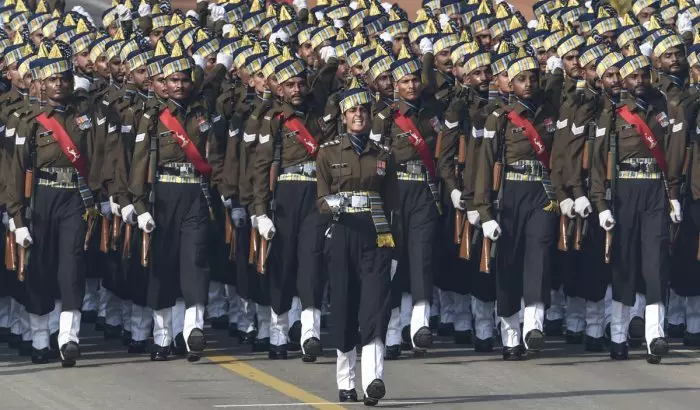
SC to Centre: If women can fly Rafale, why not more of them in Army legal branch?
Judge emphasizes the fact that gender neutrality does not mean the posts are divided 50:50 but that the posting can be filled by a member of any gender

If a woman can fly a Rafale fighter jet in the Indian Air Force, then why are fewer women officers in gender-neutral posts of Judge Advocate General (legal) branch of the Army? This was the question posed by the Supreme Court as it questioned the Centre's rationale of a 50-50 selection criterion for the JAG posting.
A bench of Justices Dipankar Datta and Manmohan on May 8 reserved its verdict on the plea of two officers, Arshnoor Kaur and Astha Tyagi, who, despite securing 4th and 5th ranks, respectively — higher in merit than their male counterparts — weren't selected for the JAG department due to the 50 per cent vacancies earmarked for women.
Also read: How Col Sofiya Qureshi's feats led to a landmark SC verdict on women officers
The officers challenged the system of earmarking the vacancies and said they could not be selected as there were only three vacancies for women out of the total six.
Bench verdict
"Prima facie, we are satisfied with the case set up by the petitioner 1 Arshnoor Kaur," the bench noted while reserving its verdict.
The top court went on, "Accordingly, we direct the respondents to initiate whatever action is required for the purpose of her induction in the next available training course for appointment as Judge Advocate General (JAG)."
Also read: 'Let's not bring their morale down in current scenario': SC on women Army officers
The bench was informed that the second petitioner Tyagi joined the Indian Navy during the pendency of the proceedings.
Why so difficult to join JAG?
The bench referred to a newspaper article that a woman fighter pilot would be flying Rafale aircraft and said that in such a scenario, she could be taken as a prisoner of war, showing the bravery and tenacity of women in the armed forces.
Therefore, the Army cannot deny women their rightful postings on the basis of gender, the court said.
Also read: Operation Keller: Indian Army kills 3 terrorists in Shopian encounter
"If it's permissible in the Indian Air Force for a lady to fly a Rafale fighter jet, then why is it so difficult for the Army to allow more women in JAG?" Justice Datta asked Additional Solicitor General Aishwarya Bhati, who was appearing for the Centre and the Army.
Not 50:50 but equality
The top court questioned the Centre, asking why the posts were termed gender-neutral when women candidates with higher merit could not qualify owing to the vacancies still being bifurcated on gender.
Justice Manmohan expressed his doubt, asking whether 10 women officers would be appointed as officers in the JAG branch if all 10 women qualified solely on the basis of merit.
The judge emphasized the fact that gender neutrality does not mean the posts are divided 50:50 but just means that the posting can be filled by a member of any gender.
Also read: What Op Sindoor marked in warfare: More power to air force, zero boots on ground
Bhati submitted her statement saying that the induction and employment of women officers in the Army, including the JAG branch, was a progressive process keeping in view its operational preparedness.
"To say the policy of intake of men and women officers from 2012 to 2023 in the ratio of 70:30 (or now being 50:50) was discriminatory and violative of fundamental rights would not only be incorrect but will also transgress into the domain of the Executive, which is the only competent and sole authority for deciding the intake of men and women officers in the Indian Army," she said.
'Gender-specific vacancies present in all branches'
Bhati further defended the Centre’s decision and said gender-specific vacancies were present in all branches of the Army based on the manpower assessment and requirement.
"The functioning of JAG branch cannot be seen in isolation as mere legal advisors to military commanders during peacetime. It's an integral part of the Indian Army with an equally important role in its operational preparedness," she said.
Conducting separate SSBs for men and women are a necessity due to the nature of tests involved, which require close intensive physical interactions, Bhati added.
Also read: PM Modi chairs Cabinet Committee on Security meet
Evolving process
Bhati called the aspect of gender integration in the defence services an evolving process, calibrated to the operational needs and subject to periodic review and studies.
"The intake policies have evolved progressively from a 70:30 ratio to 50:50 from 2024. This is aligned with cadre health and deployment restrictions, which is not arbitrary. Any judicial imposition of parity or neutrality without factoring operational imperatives is likely to undermine both command and control and operational preparedness of the Army," she said.
Previously, when the top court asked why JAG women officers were not deployed in combat zones merely due to threat perception, Bhati called it a "conscious decision" on part of the government of India to restrict women officers from frontline combat deployment as it made them susceptible to enemy contact.
(With agency inputs)

